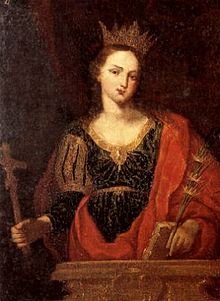St. Venera
| Saint Venera | |
|---|---|
 |
|
| Martyr | |
| Born | Acireale or Gaul |
| Died | 143 AD Rome, Acireale, or Gaul |
| Venerated in |
Roman Catholic Church Eastern Orthodox Church |
| Major shrine | Acireale Cathedral |
| Feast | November 14 ; July 26 |
| Attributes | crown; book; palm; cross; a palm of martyrdom interlaced with a triple crown (signifying the fact that she was a Virgin, an Apostle, and a Martyr) |
| Patronage | Acireale; Santa Venera, Malta; Grotte, Santa Venerina, Avola; in Sicily, invoked against volcanic eruptions, specifically those associated with Mount Etna, as well as earthquakes. |
Saint Venera (Veneranda, Veneria, Venerina, Veneranda Parasceve) is venerated as a Christian martyr of the 2nd century. Little is known of this saint. The date of her death is traditionally given as July 26, 143 AD.
In the Catalogo Sanctorum, composed by Pietro de Natalibus between 1369 and 1372, he cites in Chapter 61 the name of a virgin martyr named Veneranda. According to de Natalibus, Veneranda was born in Gaul in the 2nd century and martyred in Rome during the time of Emperor Antoninus Pius (138-161 AD).
A version of her legend states that Venera, as a girl, studied the Gospel with zeal, and left her home in Gaul to become a missionary. She travelled to Grotte, in Sicily, and preached there, and lived in a cave, near the present-day Corso Garibaldi. She became well loved amongst the local populace, and she tended to the sick. It is said that her visits would leave behind a scent of roses. She was kidnapped and taken to Acireale, and was subjected to tortures there, including being boiled in hot oil, from which she emerged even more beautiful than before. Ultimately, she was decapitated. Her body was placed in the catacomb of Santa Domitilla.
According to one version of her legend, her parents were two noble Christians named Agatho (Agatone) and Hippolyte (Ippolita). When their daughter was born, the mother wanted to call her Venera, but the father, not wanting to create associations with the goddess Venus, changed his daughter’s name to Veneranda, a rough Latin translation of the Greek name Paraskevi ("Friday," literally "Preparation"). Venera or Veneranda studied the Scriptures and lives of the martyrs as a child, and when her parents died, she dedicated herself to helping the poor and the sick. She distributed her wealth across Sicily. She preached on the Italian mainland as well, such as at Calabria and Campania.
She was on her way to Rome when she was arrested by the Roman prefect Antonius, who attempted to force her to renounce her faith with temptations and an offer of marriage, and then by torture. Antonius had her wear a helmet of red-hot iron, had her nailed on a cross, and placed on her chest a large block of sandstone. However, Venera survived all of these tortures and converted the men who were assigned to torture her. The prefect had her placed in a hot cauldron of oil and sulfur for seven days, but Venera was unharmed. The prefect, after seeing that Venera was unharmed, asked the saint if it was magic that was keeping her unharmed. When Venera asked the prefect to approach the cauldron to determine this, he refused. Venera then scooped up some of the burning sulfur and oil in her hand, and threw it in the prefect’s face, blinding him. Subsequently, Antonius freed her and converted to Christianity.
...
Wikipedia
